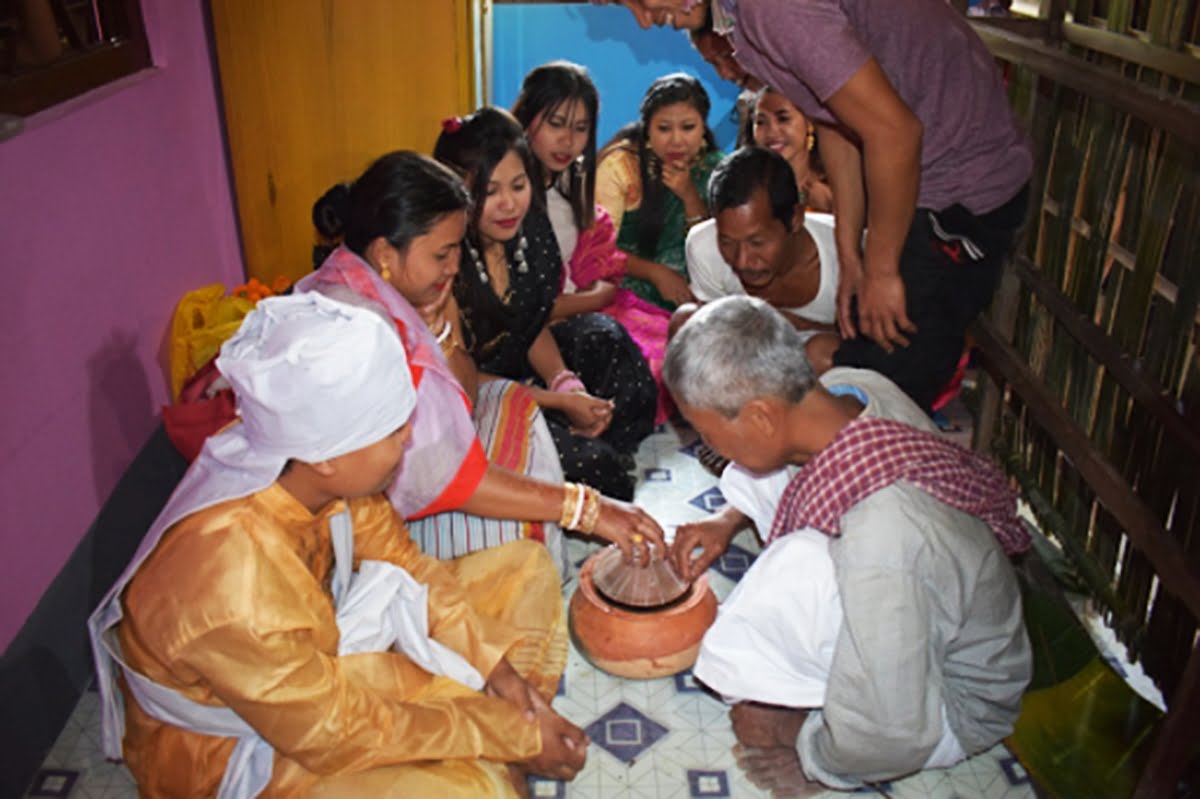Posted by Kulungti Jamatia
It is estimated that 21 dowry deaths take place in India every day. Despite being outlawed in 1961, the practice continues unabated with 95% of marriages witnessing an exchange of dowry. The cultural practice creates conditions for the harassment, subjugation, and muder of thousands of women every year. But, not all communities in India subscribe to the patriarchal notion that a girl’s family must pay the groom’s family for receiving their daughter. Adivasi societies around the country have never initiated the concept as part of their tradition.
For instance, among the Jamatia community of Tripura, marriages exemplify gender equality as can be traced back to my own family: My late grandfather, Beni Chandra Jamatia, was one of eight siblings, all boys. He was a hardworking and talented farmer and musician who went on to be awarded a Padma Shri in 2020 for his poetry. He also happened to be a chamri ompa, a man who left his maternal home to start his married life at the bride’s home, accepting her family as his.
Non-Adivasi societies have been ignoring and vilifying Adivasi practices as “primitive” instead of adopting the ones that could aid in a more egalitarian social structure. 21 dowry deaths every day should be a wake-up call.
Among the Jamatia community chamri ompa was a very common practice. At the time of marriage, families used to decide whether to send the daughter to the in-laws or to welcome a son-in-law, depending on the circumstances. If the girl’s family required additional people to take care of the property and farm, the son-in-law would be asked to move in with them and vice versa. Contrary to non-tribal societies where “ghar jamai” evokes sentiments of shame, among the Jamatia community, a person’s prowess was not decided by the conditions of marriage.
Also read: Adivasi Literature: Indigenous Stories Must Be Made Available To More Readers
Such equality of marriage also meant that there was no dowry involved. Both men and women were valued for their intelligence and hard work, and were believed to contribute equally towards the prosperity of the household. Another reason behind the absence of dowry was that daughters who stayed at home after marriage had equal rights over her ancestral property. The newly-wed couple are given the land and resources to start a family. On the other hand if a bride decides to go to the groom’s family, she has rights over her husband’s share of the property. These days the practice of chamri ompa is disappearing as more and more couples have begun to live separately from their parents owing to the nature of jobs. However, Jamatias still do not exchange any dowries.
The indigenous communities of Tripura are not alone in not having the concept of dowry. The custom is absent in a majority of Adivasi communities in India. Whether it is in Chhattisgarh, Jharkhand, or Odisha, Adivasi women enjoy a higher status in society as their marriage expenses are not a serious concern for the community. Indeed in some cases, dowry is given to the girl’s family, but even that practice is now dwindling.
A look at the 2016 National Crime Records Bureau (NCRB) data suggests that states with high Adivasi populations record the lowest occurrence of deaths related to dowry. North-East India is one such region that is considered a dowry-free zone. Among Adivasi communities of Central India too, like the Baigas, dowry is not the norm.
A look at the 2016 National Crime Records Bureau (NCRB) data suggests that states with high Adivasi populations record the lowest occurrence of deaths related to dowry. North-East India is one such region that is considered a dowry-free zone. Among Adivasi communities of Central India too, like the Baigas, dowry is not the norm. According to an article published on Feminism in India, among the Baigas, “the groom’s family visits the bride’s family with two bottles of alcohol as a sign of establishing a relationship between the two families.” The wedding ceremony entails mock-fights, dance, and music. The groom then puts a ring on the bride’s finger to solemnize the marriage.

It is unfortunate that 60 years after dowry was made illegal, the practice continues to shadow marriages in India. The laws are ineffective and are easily misused leading to incarceration of many innocent people.
Also read: Why Do We Need To Stop The Culture Of Tribal Tourism In India?
Adivasi communities have been more progressive when it comes to gender equality. Whether it is the idea of labour, sexuality, or rights over ancestral property, women have held powerful positions. Among Jamatias, a bride is considered to augment the status of the groom’s family rather than be a financial burden. However, non-Adivasi societies have been ignoring and vilifying Adivasi practices as “primitive” instead of adopting the ones that could aid in a more egalitarian social structure. 21 dowry deaths every day should be a wake-up call.
Sources of information for chamri ompa practice:
1. My parents Hiran joy Jamatia and Purnini Jamatia
2. Tripurar Adivasi written by Nagendra Jamatia
This article has been created as a part of the Adivasi Awaaz project, with the support of Misereor and Prayog Samaj Sevi Sanstha.
Editor’s note: This article has been republished from Adivasi Lives Matter with permission.
Featured image source: Adivasi Lives Matter
About the author(s)
An online platform to challenge the generational neglect of indigenous peoples in India. #AdivasiLivesMatter





Make marriage jewellery free also. Don’t take expensive jewellery from men. Don’t ask men about their house, car, job, salary, etc. Stop treating men like ATMs.